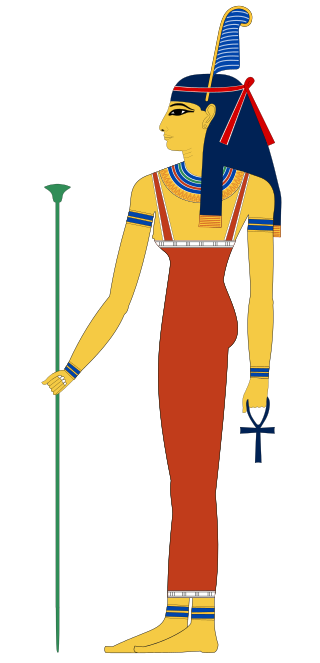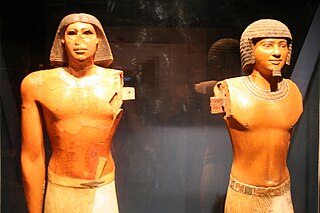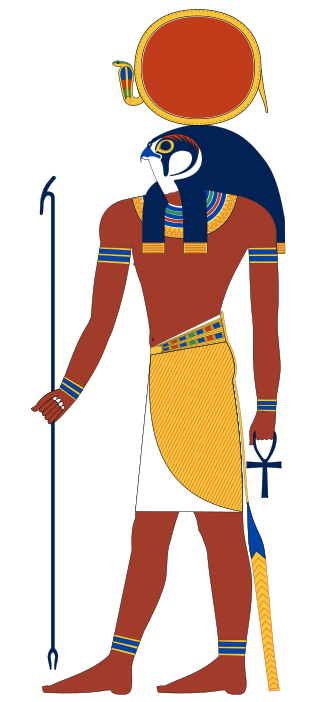Notable works
One Egyptian figure sometimes considered an early 'philosopher' is Ptahhotep. [2] He served as vizier to the pharaoh in the late 25th, early 24th century BC. Ptahhotep is known for his work on ethical behavior, called The Maxims of Ptahhotep. The work, which is believed to have been compiled by his grandson Ptahhotep Tjefi, is a series of 37 letters or maxims addressed to his son, Akhethotep, speaking on such topics as daily behavior and ethical practices. [3] [4]
Dag Herbjørnsrud, writing for the American Philosophical Association, describes the 3200-year-old manuscript "The Immortality of Writers", or "Be a Writer" (c. 1200 BC), as a "remarkable example of classical Egyptian philosophy." [5] The manuscript, attributed to the writer Irsesh, states:
Man perishes; his corpse turns to dust; all his relatives return to the earth. But writings make him remembered in the mouth of the reader. A book is more effective than a well-built house or a tomb-chapel, better than an established villa or a stela in the temple! [...] They gave themselves a book as their lector-priest, a writing-board as their dutiful son. Teachings are their mausolea, the reed-pen their child, the burnishing-stone their wife. Both great and small are given them as their children, for the writer is chief. [6]
Herbjørnsrud writes:
- "In 2018, projects are under way to translate several ancient Egyptian texts for the first time. Yet we already have a wide variety of genres to choose from in order to study the manuscripts from a philosophical perspective: The many maxims in “The Teaching of Ptahhotep”, the earliest preserved manuscript of this vizier of the fifth dynasty is from the 19th century BC, in which he also argues that you should “follow your heart”; “The Teaching of Ani”, written by a humble middle-class scribe in the 13th century BC, which gives advice to the ordinary man; “The Satire of the Trades” by Khety, who tries to convince his son Pepy to “love books more than your mother” as there is nothing “on earth” like being a scribe; the masterpiece “The Dispute Between a Man and His Ba” of the 19th century BC – in which a man laments “the misery of life,” while his ba (personality/soul) replies that life is good, that he should rather “ponder life” as it is a burial that is miserable [...] Or we can read Amennakht (active in 1170–1140 BC), the leading intellectual of the scribal town Deir El-Medina, whose teaching states that “it is good to finish school, better than the smell of lotus blossoms in summer.” [5]
Ancient Egyptian religion was a complex system of polytheistic beliefs and rituals that formed an integral part of ancient Egyptian culture. It centered on the Egyptians' interactions with many deities believed to be present and in control of the world. About 1500 deities are known. Rituals such as prayer and offerings were provided to the gods to gain their favor. Formal religious practice centered on the pharaohs, the rulers of Egypt, believed to possess divine powers by virtue of their positions. They acted as intermediaries between their people and the gods, and were obligated to sustain the gods through rituals and offerings so that they could maintain Ma'at, the order of the cosmos, and repel Isfet, which was chaos. The state dedicated enormous resources to religious rituals and to the construction of temples.
Monotheism is the belief that there is only one deity, an all-supreme being that is universally referred to as God. A distinction may be made between exclusive monotheism, in which the one God is a singular existence, and both inclusive and pluriform monotheism, in which multiple gods or godly forms are recognized, but each are postulated as extensions of the same God.

Aten also Aton, Atonu, or Itn was the focus of Atenism, the religious system formally established in ancient Egypt by the late Eighteenth Dynasty pharaoh Akhenaten. Exact dating for the 18th dynasty is contested, though a general date range places the dynasty in the years 1550 to 1292 B.C.E. The worship of Aten and the coinciding rule of Akhenaten are major identifying characteristics of a period within the 18th dynasty referred to as the Amarna Period.

Set is a god of deserts, storms, disorder, violence, and foreigners in ancient Egyptian religion. In Ancient Greek, the god's name is given as Sēth (Σήθ). Set had a positive role where he accompanies Ra on his barque to repel Apep, the serpent of Chaos. Set had a vital role as a reconciled combatant. He was lord of the Red Land (desert), where he was the balance to Horus' role as lord of the Black Land.

Akhenaten, also spelled Akhenaton or Echnaton, was an ancient Egyptian pharaoh reigning c. 1353–1336 or 1351–1334 BC, the tenth ruler of the Eighteenth Dynasty. Before the fifth year of his reign, he was known as Amenhotep IV.

Mut, also known as Maut and Mout, was a mother goddess worshipped in ancient Egypt. Her name means mother in the ancient Egyptian language. Mut had many different aspects and attributes that changed and evolved greatly over the thousands of years of ancient Egyptian culture.

Ptah is an ancient Egyptian deity, a creator god and patron deity of craftsmen and architects. In the triad of Memphis, he is the husband of Sekhmet and the father of Nefertem. He was also regarded as the father of the sage Imhotep.

Maat or Maʽat comprised the ancient Egyptian concepts of truth, balance, order, harmony, law, morality, and justice. Ma'at was also the goddess who personified these concepts, and regulated the stars, seasons, and the actions of mortals and the deities who had brought order from chaos at the moment of creation. Her ideological opposite was Isfet, meaning injustice, chaos, violence or to do evil.
Monolatry is the belief in the existence of many gods, but with the consistent worship of only one deity. The term monolatry was perhaps first used by Julius Wellhausen.

The Great Hymn to the Aten is the longest of a number of hymn-poems written to the sun-disk deity Aten. Composed in the middle of the 14th century BC, it is varyingly attributed to the 18th Dynasty Pharaoh Akhenaten or his courtiers, depending on the version, who radically changed traditional forms of Egyptian religion by replacing them with Atenism. The hymn bears a notable resemblance to the biblical Psalm 104.
African philosophy is the philosophical discourse produced in Africa or by indigenous Africans. African philosophers are found in the various academic fields of present philosophy, such as metaphysics, epistemology, moral philosophy, and political philosophy.

Atenism, also known as the Aten religion, the Amarna religion, and the Amarna heresy, was a religion in ancient Egypt. It was founded by Akhenaten, a pharaoh who ruled the New Kingdom under the Eighteenth Dynasty. The religion is described as monotheistic or monolatristic, although some Egyptologists argue that it was actually henotheistic. Atenism was centred on the cult of Aten, a god depicted as the disc of the Sun. Aten was originally an aspect of Ra, Egypt's traditional solar deity, though he was later asserted by Akhenaten as being the superior of all deities. In the 14th century BC, Atenism was Egypt's state religion for around 20 years, and Akhenaten met the worship of other gods with persecution; he closed many traditional temples, instead commissioning the construction of Atenist temples, and also suppressed religious traditionalists. However, subsequent pharaohs toppled the movement in the aftermath of Akhenaten's death, thereby restoring Egyptian civilization's traditional polytheistic religion. Large-scale efforts were then undertaken to remove from Egypt and Egyptian records any presence or mention of Akhenaten, Atenist temples, and Atenist assertions of a uniquely supreme god.

Ptahhotep, sometimes known as Ptahhotep I or Ptahhotpe, was an ancient Egyptian vizier during the late 25th century BC and early 24th century BC Fifth Dynasty of Egypt.

Amarna art, or the Amarna style, is a style adopted in the Amarna Period during and just after the reign of Akhenaten in the late Eighteenth Dynasty, during the New Kingdom. Whereas Ancient Egyptian art was famously slow to change, the Amarna style was a significant and sudden break from its predecessors both in the style of depictions, especially of people, and the subject matter. The artistic shift appears to be related to the king's religious reforms centering on the monotheistic or monolatric worship of the Aten, the disc of the Sun, as giver of life.

Apepi, Apophis ; regnal names Neb-khepesh-Re, A-qenen-Re and A-user-Re) was a Hyksos ruler of Lower Egypt during the Fifteenth Dynasty and the end of the Second Intermediate Period. According to the Turin Canon of Kings, he reigned over the northern portion of Egypt for forty years during the early half of the 16th century BCE. Although officially only in control of the Lower Kingdom, Apepi in practice dominated the majority of Egypt during the early portion of his reign. He outlived his southern rival, Kamose, but not Ahmose I.

The Maxims of Ptahhotep or Instruction of Ptahhotep is an ancient Egyptian literary composition by the Vizier Ptahhotep around 2375–2350 BC, during the rule of King Djedkare Isesi of the Fifth Dynasty. The text was discovered in Thebes in 1847 by Egyptologist M. Prisse d'Avennes. The Instructions of Ptahhotep are considered didactic wisdom literature belonging to the genre of sebayt. There are four copies of the Instructions, and the only complete version, Papyrus Prisse, is located in the Bibliothèque Nationale in Paris. According to William Kelly Simpson, scholars tend to believe that the Instructions of Ptahhotep were originally composed during the Middle Kingdom, specifically the Twelfth Dynasty. The earliest extant copies of the text were altered to make them understandable for the Egyptians of the New Kingdom. The text presents a very good picture of the general attitudes of that period. The Instructions of Ptahhotep addresses various virtues that are necessary to live a good life and how to live accordingly to Maat, which was an important part of the Egyptian culture.

Ancient Egyptian literature was written in the Egyptian language from ancient Egypt's pharaonic period until the end of Roman domination. It represents the oldest corpus of Egyptian literature. Along with Sumerian literature, it is considered the world's earliest literature.
Amun was a major ancient Egyptian deity who appears as a member of the Hermopolitan Ogdoad. Amun was attested from the Old Kingdom together with his wife Amunet. With the 11th Dynasty, Amun rose to the position of patron deity of Thebes by replacing Montu.

Ra or Re was the ancient Egyptian deity of the Sun. By the Fifth Dynasty, in the 25th and 24th centuries BC, he had become one of the most important gods in ancient Egyptian religion, identified primarily with the noon-day sun. Ra ruled in all parts of the created world: the sky, the Earth, and the underworld. He was believed to have ruled as the first pharaoh of Ancient Egypt. He was the god of the sun, order, kings and the sky.
This page list topics related to ancient Egypt.














